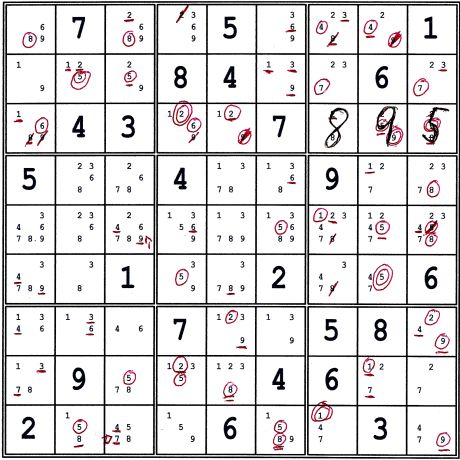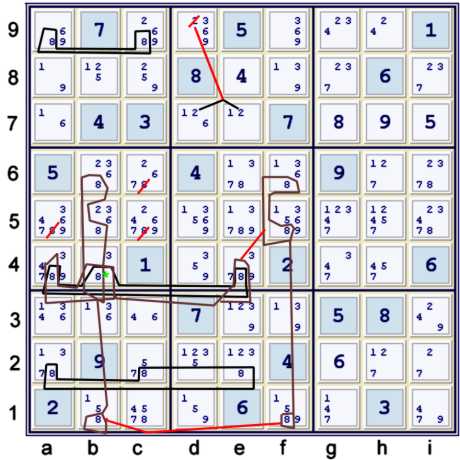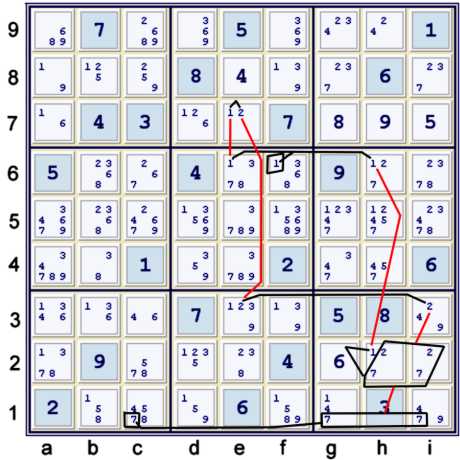The following is page three of an illustrated proof for the
sudoku.com.au tough puzzle of 01/30/08.
Page two and page one attempted to finely detail how
to find eliminations. This page will continue in similar fashion. This page, and perhaps this entire proof, has a theme:
remembering what one has found. A second related, but not quite equivalent, theme is: fully noting
possibility matrix changes. Hopefully, this page will serve as a sterling example of how remembering works for me.
Previous blog pages may be helpful. Links to these pages are found to the right,
under Sudoku Techniques. I may later list specific pages.
The illustrations of steps shown on this page will share this key:
- black line = strong inference performed upon a set (strong link)
- red line = weak inference performed upon a set (weak link)
- black containers define a partioning of a strong set(s)
- candidates crossed out in red = candidates proven false
- boxes highlight some groups
Please be aware that, for me,
strong and weak need not be mutually exclusive properties.
Mark-Up
After each elimination, including cell solutions, I find it helpful to manually update my puzzle mark-up. This forces
me to be aware of what has changed. Thus, newly stronger strong inference sets are noted. Often, I spend some time
examining those newly stronger (meaning more restricted) sis.

the mark-up above includes the result of step 3a: Locked 2s de7 => d9 ≠2. Note that candidate 8 required
multiple updates. (8)ac9 both became circled. (8)e4 received an underline because of (8)e4=(8)ab4. The next step is
the immediate result of those updates.
Steps 3a & 3b
Below, the Locked 2's elimination is graphed. Also, two different ways to achieve the same eliminations with candidate 8
are shown.

Using only candidate 8, both of the following justify a5,d56≠8:
- b456=b1-f1=f56-e4=ab4
- b4=[row swordfish ace2, ae4, ac9] - a finned swordfish.
The latter requires both stronger 8s in row 9 and row 4. The one I found first required only the stronger 8s in row 4.
Thus, although the finned swordfish is more pattern-like, the simple chain listed first is in my mind easier to spot given:
- a single candidate elimination search has been previously conducted.
- the underlined 8's in my puzzle mark-up at b1,f1,e4
It has been argued by others that finding such groupings is beyond typical human pattern recognition. This is not only silly,
but clearly only true if one chooses not to ever look for them.
Finally, note the exquisite symmetry between the two chains making the same elimination: both have the same appendage
that prevents a continuous, or wrap around situation: (8)b4. Furthermore, without (8)b4, both would have precisely the
same targets. Somewhere, lurking within this symmetrical relationship lies a deep uniqueness of solution argument.
But, I digress.
Step 3c
Below, the new Bivalue (1=2)e7 plays an important role. Some may prefer two chains.

The key to this one is the ALS (127)hi2. Thus, in that box we have the equivalent of the additional sis: (1=7)hi2 and (1=2)hi2.
(1=2)hi2 is the most important in this deduction, as the new (1=2) at e7 forms the equivalent of a Y wing style:
- (1=2)e7-(2)e3=(2)i3-(2=1)hi2
The chain, as shown above, also recognizes the continuation: (1)g1=(1)g5. Thus, the entire chain written more formally:
- (1=2)e7-(2)e3=(2)i3-(pair27)hi2=(1)h2-(1)g1=(1)g5 => e25≠1
Thus, the key to this one, for me, is not only recognizing the sis (1=2)hi2 created by the ALS(127)hi2, but more importantly
realising that the new sis,
(1=2)e7, and the old sis,
(1=2)hi2, can be easily linked.
Step 3d Prelude 1
Below, step 3c revealed an Almost Wrap Around Chain that is readily apparent if one looks for such animals. Moreover, note
the overlap with the previous step.

Finding Almost Wrap-Around Chains is usually worth the effort. This is because such an almost chain has
mulitple weak links emanating from it, or alternatively, almost proves multiple sis. Recall that with a standard wrap around
chain all the weak links are proven strong. Thus, above,
- (1)f6=[wrap around chain: (1=2)e7-(2)e3=(2)i3-(pair27)hi2=(1)h2-(1)h6=(1)e6]
- => (1)f6=sis list[(1)e67, (2)e37, (7)hi2, (2)i3hi2, (1)h26]
That is a lot of potential bang for the buck. In my head, I recognize (7)gi1=(7)c1 because (7)c1 is underlined in the
puzzle mark-up. Thus, to remember this chain snippet, I note in the margin of my puzzle mark-up only: (1)f6=(7)c1. Since
step
3c used four of the same sis, this shorthand is quite sufficient.
Step 3d Prelude 2
The ALS(23678)b456c6 creates the strong link:(7)c6=(8)b456. Although it proves other sis, this one creates a clear
partition of candidates (78) in columns bc. Since I tend to prefer Hidden sets, what I saw was the equivalent condition
using Almost Hidden Pair 49 at a45,c5. Step 3b eliminated (8)c6, and caused me to note this new stronger
partition. Note therefor the Almost Chain:
- [(8)c1=*(8)b1-(8)b456=(7)c6]-(7)c1
- => (8)f1=[(8)c1=*(8)b1-(8)b456=(7)c6]-(7)c1=(7)gi1
which proves the sis:
One can now trivially combine Prelude 1 with Prelude 2:
- (1)f6=(7)c1-(7)gi1=(8)f1
- => f6≠8 & f1≠1
Digression: After finding this chain, I noted that the elimination of (8) from c6 is not required to eliminate
(8) from f6. Proving this is easy: (8)c6=[(8)f1=(1)f6]. Speculations about these sort of possible chains created the
impetus for examining
Almost Alternating Inference Chains (AAIC) .
End of Historical Note Digression.
Step 3d - Linked AAIC
Below, I graph Prelude 1 and Prelude 2 together. The deduced chain, therefor:
- (1)*f6=[(1)*e6=(1)*h6-(1)h2=(pair27)hi2-(2)i3=(2)e3-(2=1)e7]-(7)gi1
- =(7)c1-[[(7)c6&(-8)**c1]=(ht479)a45c5-(8)a4=(8)b465-(8)**b1]=(8)**f1
- => (1)f6=(8)f1 => f1<>1, f6<>8 native depth 11
For reference, and to illustrate how a
Mixed Block Matrix handles such an animal, one can study the matrix below.
Note that there are two
Symmetric Pigeonhole Matrix blocks, both of which are indicated by
bold characters.
Please remember: the finding of such an animal can be done in at least two distinct, but formally related manners:
- Linking AIC chain snippets, as fully illustrated above
- Counting potential matrix rows versus columns, as described in previous blog pages
| 1r6 |
f6 |
e6 |
h6 |
|
|
|
|
|
|
|
|
| e7 |
| 1 | | 2 |
| | | |
| | |
| 2r3 |
| | | e3 |
i3 | | | |
| | |
| i2 |
| | | |
2 | 7 | | |
| | |
| h2 |
| | 1 | |
2 | 7 | | |
| | |
| 7r1 |
| | | |
| gi1 | c1 | |
| | |
| c6 |
| | | |
| | 7 | 2 |
6 | | |
| b6 |
| | | |
| | | 2 |
6 | 3 | 8 |
| b5 |
| | | |
| | | 2 |
6 | 3 | 8 |
| b4 |
| | | |
| | | |
| 3 | 8 |
| 8r1 |
f1 | | | |
| | c1 | |
| | b1 |

Not shown: Afer making these eliminations,
- Step 3e: (Hidden Pair 58)f15 => f1≠9 & f5≠1369
This requires a refresh of my puzzle mark-up, as now (9)d1=(9)i1, (6)d5=(6)f6, (8)f1=(8)f5. Circling the (6) at
f6 and (6) at d5 provided an essential clue for the next cascaded step.
Step 3f Prelude
Below,
- (6)d5=[(6)f6-(1)f6=(7)c1see previous step]-(67)c6=(2)c6
- => (6)d5=(2)c6.

At this point, I note in my puzzle mark-up both 1 & 2 underlined at b8. These serve as a clue for a helpful
continuation to (6)d5=(2)c6.
Step 3f

Above, to make the graphing easier, I have replaced (1)b8=(1)b13 with (1)b8=(1)a78. Also, (2)b8=(2)b56 is
replaced with (2)c89=(2)b8. However, the underlined (12)b8 meant the latter. The chain now reads:
- (6)d5=(2)c6-(2)c89=(2-1)b8=(1)a78-(1)a2= [(1) d2=h2-g1=g5]
- => d5≠1
- => circle (1)e6,(1)f6 => (not shown)
- step 3g Locked 1s ef6 => h6≠1
If one cares to, one can find a chain, depth 9, that replicates step 3f. I generally do this, as it helps me to understand
other things about the puzzle. I guess one could call that activity puzzle study. I find it often helpful. Here, my notes
say
D9 poss, meaning independent Depth 9 chain possible to achieve the same elimination. Independent means that
it requires no knowledge of any previous steps. But, again I digress!
For reference and illustration purposes, below find an 8x8 Triangular Matrix that is actually depth 9. In bold,
note that I treat the ALS(127)hi2 as a single Boolean:(1)h2=(pair27)hi2. This can be done freely without any loss of generality.
| 1g |
g5 |
g1 |
|
|
|
|
|
|
| 1r2 |
d2 | h2 | a2 | |
| | | |
| 1b |
| | b13 | b8 |
| | | |
| 2b |
| | | b8 |
b56 | | | |
| hi2 |
| 1 | | |
| p27 | | |
| 7r1 |
| | | |
| gi1 | c1 | |
| c6 |
| | | |
2 | | 7 | 6 |
| 6Bx5 |
d5 | | | |
| | | f6 |
Alternate Step 3f - simple TM
This content has been added later. First, let me apologize. Oftentimes, I find many ways to justify the same elimination.
What follows is another way to achieve step 3f. One could write this alternative as an AIC, but it is a bit messy.
The idea has some overlap with the previous two manners shown to achieve d5≠1:
- [(1):g5=g1-h2=*d2]=*(1)a2-[(1)b13=(1-2)b8=(2)b56-(2=7)**c6-(7)a45=(7)a2]=(6)**c6-(6)f6=(6)d5
- => sis[(1)g5,(1)d2,(6)d5] => d5≠1
The key to finding this one is the confluence of underlines:
(1)b8, (2)b8, (7)a2
yielding [(1)d2=(1)h2]=(6)c6 when combined with (267)c6
As a TM, depth 7:
| 1g |
g5 |
g1 |
|
|
|
|
|
| 1r2 |
d2 | h2 | a2 | |
| | |
| 1b |
| | b13 | b8 |
| | |
| 2b |
| | | b8 |
b56 | | |
| 7a |
| | a2 | |
| a45 | |
| c6 |
| | | |
2 | 7 | 6 |
| 6B5 |
d5 | | | |
| | f6 |
Step 3h - ALS again.
The ALS(127)h26 became a bit stronger with the introduction of the bivalue (2=7)h6. Having noted earlier the relationship:
- (2)g789=(2-1)g5=(1)g1 in step 2c
It is easy now to find:
- (2)g89=(2-1)g5=(1)g1-(1)h2=(pair27)h26
- => h9≠2
- => (4)h9 %cell, thus UP 28
After this step, I noted but did not use:
- AUR 27 hi26 => (38)i6=[pair 27 @ h6,(2=7)h45] => i6≠27
justified by mxing and matching naked/hidden sets:
- (naked pair27)i26-AUR(Hidden pair27)h26=(pair27)h6,h45
Although this elimination is in my scrap heap, I thought some may find it interesting in format. This step becomes
available after (4)h9 because of the newly stronger 2's column h. This new strength is indicated by the underline one
would place under 2 at h2, meaning (2)h2=(2)h456.
This proof continues on Page four. Significant progress
has been made.